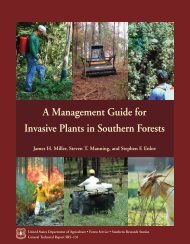Safflower Rust
Safflower Rust
Safflower Rust
Create successful ePaper yourself
Turn your PDF publications into a flip-book with our unique Google optimized e-Paper software.
High Plains IPM Guide, a cooperative effort of the University of Wyoming, University of Nebraska, Colorado State University andMontana State University.<strong>Safflower</strong><strong>Rust</strong>Howard F. Schwartz and David H. GentIdentification and Life Cycle<strong>Rust</strong> of safflower is caused by the fungus Puccinia calcitrapae var. centaureae (syn.=P.carthami). The life cycle of rust is complex, and involves five different spore stages.The rust pathogen may overwinter and reappear the next spring when teliosporesgerminate to form basidiospores that then infect volunteer safflower. Infected plantsproduce pycnia (yellow blisters on the upper leaf surface) and aecia (white cups) on thelower leaf surface or stems near the soil line. Aeciospores move with the wind currentsand infect newly planted safflower, resulting in summer spore production. Summerspores are produced in repeating cycles of progressive disease development throughoutthe summer. Summer spores are moved long distances (regionally) by wind.Repeating cycles of summer spore development may occur at 10 to 14 day intervalsunder favorable conditions. The earlier plants become infected during development, thegreater the potential for yield loss.Plant Response and Damage<strong>Rust</strong> symptoms first appear on the upper and/or lower surfaces of leaves as small yellowor white slightly raised spots. These spots enlarge and raise further to form reddishbrownor rust-colored pustules which are about 1/8 inch diameter and contain thousandsof microscopic spores called urediniospores (summer spores) which allow the fungus tospread within and between fields. A yellow border may surround pustules. Spores arereadily released from the pustule and give a rusty appearance to anything they contact.Spores feel like talcum powder when rubbed between the fingers. Severe infection resultsin premature leaf drop. Near the end of the season, many pustules change color, andform dark brown to black teliospores (winter spores), which allow the fungus to overwinter in some production areas. Yield losses can approach 100% on susceptiblevarieties.Management ApproachesHigh Plains IPM Guide, a cooperative effort of the University of Wyoming, University of Nebraska, Colorado State University andMontana State University.
High Plains IPM Guide, a cooperative effort of the University of Wyoming, University of Nebraska, Colorado State University andMontana State University.Biological ControlBiological control strategies have not been developed for rust of safflower.Cultural ControlPlant certified seed of varieties resistant to the prevalent races of rust in the area. Avoidthe use of susceptible varieties, especially when planting after June 25, since plants maybe exposed to more spore pressure from earlier maturing fields during late August andearly September. Incorporate infected crop debris into the soil after harvest and rotatewith non-host crops for at least two years. Eliminate volunteer safflower the followingseason.Chemical ControlSeed treatments provide some suppression of rust, but should be integrated with soundcultural practices.Product List for <strong>Rust</strong>:PesticideRate per 100 lbseedApplicationFrequency (days)RemarksCaptanCaptan 75 6-9 oz Seed treatment Broad spectrum, but weak againstPythium and Phytophthora spp.Captan 30-DD 1.25 fl oz Seed treatment Broad spectrum, but weak againstPythium and Phytophthora spp.Captan 400 1-2 fl oz Seed treatment Broad spectrum, but weak againstPythium and Phytophthora spp.Captan 400-C 1-2 fl oz Seed treatment Broad spectrum, but weak againstPythium and Phytophthora spp.Carboxin and Carboxin + ThiramVitavax 34 2 fl oz Seed treatment Suppression of RhizoctoniaVitavax 200 4 fl oz Seed treatment Broad spectrumEBDC—several formulations available, but not all are listedDithane M45 2 oz Seed treatment Broad spectrumFludioxonilMaxim 4FS 0.08-0.16 fl oz Seed treatment Suppression of Fusarium andRhizoctonia spp.Thiram42-S Thiram 8 fl oz Seed treatment Broad spectrumThiram 50WP 8 oz Seed treatment Broad spectrumThe information herein is supplied with the understanding that no discrimination is intended and that listing of commercial products, necessary to thisguide, implies no endorsement by the authors or the Extension Services of Nebraska, Colorado, Wyoming or Montana. Criticism of products or equipmentnot listed is neither implied nor intended. Due to constantly changing labels, laws and regulations, the Extension Services can assume no liability for theHigh Plains IPM Guide, a cooperative effort of the University of Wyoming, University of Nebraska, Colorado State University andMontana State University.
High Plains IPM Guide, a cooperative effort of the University of Wyoming, University of Nebraska, Colorado State University andMontana State University.suggested use of chemicals contained herein. Pesticides must be applied legally complying with all label directions and precautions on the pesticidecontainer and any supplemental labeling and rules of state and federal pesticide regulatory agencies. State rules and regulations and special pesticide useallowances may vary from state to state: contact your State Department of Agriculture for the rules, regulations and allowances applicable in your stateand locality.Categories: <strong>Safflower</strong>, Disease, <strong>Rust</strong>Date: 3/3/2005High Plains IPM Guide, a cooperative effort of the University of Wyoming, University of Nebraska, Colorado State University andMontana State University.
















